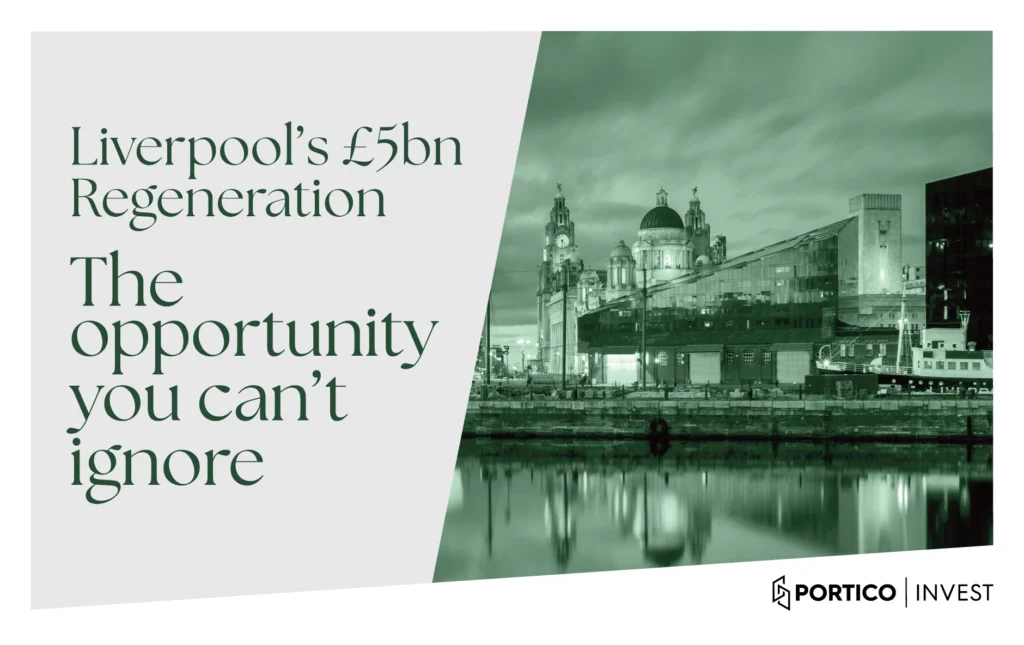Liverpool’s £5bn Regeneration: The Investor’s Guide to Bramley-Moore Dock, Knowledge Quarter, and Fabric District
Liverpool is in the midst of a spectacular renaissance. A historic city famed for its maritime past and cultural exports, it is now at the forefront of a £5 billion regeneration drive that is reshaping its landscape and revitalizing its economy. For savvy property investors, this transformation represents a compelling opportunity.
Here we delve into three of the city’s most significant regeneration zones: Bramley-Moore Dock, the Knowledge Quarter, and the Fabric District. We will explore what these projects involve, and crucially, how they are creating a powerful case for off-plan buy-to-let property investment, offering a dual benefit of capital appreciation and soaring rental demand for investors, while simultaneously improving the quality of life for residents.
The Global Appeal of Liverpool
Before we examine the specific regeneration areas, it’s important to understand the broader context. Liverpool’s property market has consistently outperformed many other major UK cities, offering exceptional value with property prices significantly below the national average. This affordability, combined with robust rental yields, has made it a hotspot for investors.
The city’s youthful population, driven by its three major universities and a booming professional workforce, ensures a steady and increasing demand for rental properties. The ongoing regeneration projects are not just about new buildings; they are about creating a new economic and social ecosystem that will attract more businesses, jobs, and residents, further solidifying Liverpool’s position as a prime investment destination.
Bramley-Moore Dock: A New Waterfront Landmark
The Bramley-Moore Dock project is arguably the most high-profile and transformative of Liverpool’s current regeneration schemes. This development is not merely a single project, but a cornerstone of the wider £5.5 billion Liverpool Waters initiative, a 30-year vision to transform the city’s northern docks.
What the Regeneration Involves
At the heart of the Bramley-Moore Dock regeneration is the construction of a brand-new, state-of-the-art football stadium for Everton FC. The 52,888-seat stadium, a major catalyst for change, is just the beginning. The wider project includes:
- Public Realm Improvements: Significant investment is being made to improve public spaces, including new public access to the docks and the restoration of historic features.
- The “Goodison Legacy Project”: Everton FC’s former home, Goodison Park, will be redeveloped into a mix of housing, retail, and community facilities, creating a lasting legacy for the local area.
- Accelerated Development: The new stadium is expected to act as a magnet for further investment in the northern docks, fast-tracking the development of new commercial and residential spaces.
- Job Creation: The project is projected to create thousands of jobs, both in construction and in new roles at the completed stadium and surrounding businesses.
The Investor and Tenant Advantage
For investors, the Bramley-Moore Dock regeneration is a powerful driver of capital appreciation. Historically, major infrastructure projects, particularly those involving iconic landmarks like a new stadium, have a profound effect on property values in the surrounding postcode areas. The anticipated influx of visitors and the creation of a vibrant new destination will make the area increasingly desirable.
For tenants, this regeneration promises a dramatically improved quality of life. The development will bring new amenities, better transport links, and a more attractive, well-maintained environment. Residents will benefit from a revitalized waterfront, new public spaces, and the economic opportunities created by the project. The “Goodison Legacy Project” ensures that the benefits extend beyond the immediate dockland area, creating a thriving community hub for existing residents.
The Knowledge Quarter: A Hub of Innovation and Growth
Situated in the heart of Liverpool, the Knowledge Quarter (KQ Liverpool) is a 450-acre innovation district that is rapidly establishing itself as a national hub for science, technology, education, and health. The regeneration of this area is focused on fostering an ecosystem of high-growth sectors, attracting talent, and retaining the city’s brightest minds.
What the Regeneration Involves
The KQ Liverpool regeneration is a multi-phase, multi-billion-pound expansion. Key components include:
- Paddington Village: This flagship expansion site is set to attract over £1 billion in investment. It will house 1.8 million sq ft of new science, technology, education, and health space, creating a major destination for research and development.
- New Laboratory and Workspace: The plan includes the development of over 1 million sq ft of cutting-edge lab and educational space, designed to support start-ups and SMEs in high-tech industries like materials chemistry, AI, and robotics.
- Talent Retention: A key focus is on retaining the city’s vast student talent pool by creating high-skilled, high-paid jobs in the city.
- Improved Connectivity: The project includes plans for better public transport and infrastructure to connect the Knowledge Quarter with the wider city and region.
The Investor and Tenant Advantage
The Knowledge Quarter is a magnet for high-earning professionals, researchers, and students, creating a strong and reliable tenant pool. For buy-to-let investors, this translates into a sustained demand for quality rental properties and the potential for exceptional rental yields. The regeneration’s focus on creating an “innovation generation” means that the area is future-proofed, with a long-term economic strategy that will continue to drive property value growth.
For tenants, living in the Knowledge Quarter means being at the epicentre of a dynamic and exciting community. The new developments offer modern living spaces, often with access to high-quality amenities. The creation of a vibrant, mixed-use neighbourhood with leisure, retail, and cultural spaces will create an environment where people can both live and work, reducing commute times and fostering a strong sense of community.
The Fabric District: A Creative and Connected Quarter
The Fabric District, nestled between the Knowledge Quarter and Lime Street, is a rapidly emerging creative hub. This regeneration is focused on preserving the area’s unique character while revitalizing its urban fabric to support a new generation of businesses and residents.
What the Regeneration Involves
Recent and ongoing projects in the Fabric District include:
- Public Realm and Infrastructure: Major investment is being made to improve public spaces, with plans to transform Monument Place into a high-quality district square with new paving, landscaping, and event spaces.
- Enhanced Connectivity: The regeneration includes dedicated bus-priority lanes and upgraded traffic signals on London Road, as well as improved walking and cycling connections, making the area more accessible and eco-friendly.
- Commercial and Residential Growth: The revitalisation of the area is intended to attract new investors and support commercial and residential growth, with a focus on arts, textiles, and design.
The Investor and Tenant Advantage
The Fabric District offers a unique investment proposition. Its location, bridging the creative buzz of the city centre with the academic powerhouse of the Knowledge Quarter, makes it highly attractive to a diverse range of tenants. From students to creative professionals and young families, the area’s blend of heritage and modernity is a major draw. The public realm improvements will enhance the aesthetic and functional appeal of the area, directly contributing to both capital appreciation and rental demand.
For tenants, the Fabric District offers a lifestyle that is both vibrant and convenient. The improved public transport and walking links make it easy to navigate the city, while the new public squares and green spaces create a healthier, more pleasant environment. The area’s focus on creative industries and local businesses means residents will have access to unique shops, cafes, and cultural venues, creating a distinct and appealing neighbourhood.
A Powerful Synergy for Property Investors
The combined impact of these three regeneration projects is more than the sum of its parts. They are creating a synergistic effect that elevates Liverpool’s entire property market.
- Capital Appreciation: Each project acts as a catalyst, driving up property values in its immediate vicinity and creating a ripple effect across the city.
- Increased Rental Demand: The creation of thousands of new jobs, the attraction of a highly skilled workforce, and a growing student population will ensure a sustained and increasing demand for rental properties.
- Higher Rental Yields: The combination of affordable entry prices and rising rental demand will lead to strong and potentially increasing rental yields for investors.
For those considering an off-plan buy-to-let property, investing in Liverpool’s regeneration zones is not just a bet on the city’s future—it’s an opportunity to get in on the ground floor of a major urban transformation. By understanding the specific projects at Bramley-Moore Dock, the Knowledge Quarter, and the Fabric District, investors can strategically position themselves to benefit from the city’s remarkable growth story, while also contributing to the creation of a better, more vibrant Liverpool for all its residents.

